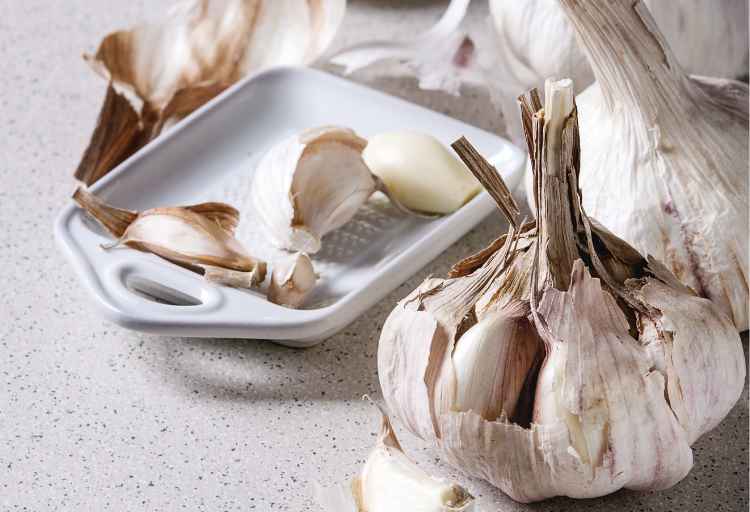What Are The Brown Spots On Garlic
Have you ever noticed brown spots on your garlic and wondered what they are? Those unsightly spots can be a cause for concern, but understanding the reasons behind them can put your mind at ease.
Brown spots on garlic, also known as browning, occur due to a variety of factors. In this article, we will explore what causes garlic browning and its impact on the quality of the garlic. We will debunk common myths and misconceptions surrounding this issue and provide you with practical tips to prevent garlic browning.
Additionally, we will address whether or not these brown spots are harmful and how to use garlic with browning effectively. So, if you want to ensure that your garlic is in top-notch condition and learn more about the factors affecting its quality, keep reading!

Garlic Browning: What Causes It?
Have you ever wondered why your garlic develops those unsightly brown spots? Garlic browning occurs when enzymes in the garlic react with oxygen, causing a chemical reaction called enzymatic browning. This process is accelerated by factors such as bruising, cutting, or even just exposure to air.
When garlic is injured or exposed to oxygen, it releases an enzyme called alliinase, which reacts with sulfur compounds in the garlic to form compounds that cause brown coloration. To prevent garlic browning, it’s important to handle your garlic with care and minimize its exposure to air.
Store your garlic in a cool, dry place away from sunlight and moisture. Avoid cutting or crushing the cloves until you’re ready to use them. Following these tips will help maintain the freshness and appearance of your garlic for longer periods of time.
The Impact of Brown Spots on Garlic Quality
You can easily determine the quality of garlic by examining its appearance. Specifically, look for the presence of discolored patches that may affect its overall taste and texture. Brown spots on garlic can have a significant impact on its storage life.
These spots are caused by enzymatic reactions and indicate that the garlic is starting to deteriorate. When brown spots appear, it means that the garlic has begun to break down and lose its freshness. As a result, the flavor and texture of the garlic may be compromised.
To identify brown spots on garlic, look for areas that are darker in color than the rest of the cloves. These spots may be soft or mushy to the touch. It’s important to remove any cloves with brown spots before using or storing your garlic to ensure you get the best quality and flavor from it.
Common Myths and Misconceptions about Garlic Browning
Contrary to popular belief, there are several misconceptions surrounding the browning of garlic that might surprise you. Many people think that brown spots on garlic indicate it’s spoiled or no longer good to use.
However, this isn’t true. Garlic browning is actually a natural process that occurs as the garlic ages and develops more flavor. It doesn’t mean the garlic has gone bad.
Another myth is that browning only happens when garlic is cooked for too long or at high temperatures. While cooking can certainly accelerate the browning process, it isn’t the only cause. Even raw garlic can develop brown spots over time due to enzymatic reactions.
So next time you see brown spots on your garlic, don’t automatically assume it’s no longer usable. Embrace the natural aging process and enjoy the enhanced flavor it brings to your dishes!
Tips for Preventing Garlic Browning
One effective way to maintain the freshness and flavor of your garlic is by storing it in a cool, dry place. This helps in preventing browning and preserving its freshness for longer periods.
Here are some tips to help you keep your garlic in top condition:
- Keep it away from moisture: Moisture can accelerate the browning process, so make sure your garlic stays dry.
- Avoid direct sunlight: Sunlight can also cause browning, so store your garlic away from windows or other sources of direct light.
- Store it in a well-ventilated container: Using a breathable container like a mesh bag or a ceramic jar with small holes allows airflow and prevents moisture buildup.
By following these simple tips, you can enjoy fresh and flavorful garlic for all your culinary creations. So remember, keep it cool, keep it dry, and savor the deliciousness!
Is Garlic Browning Harmful?
To determine if garlic browning is harmful, imagine yourself examining a clove of garlic and noticing a slight discoloration that may raise concerns about its quality.
The good news is that the brown spots on garlic are usually harmless and don’t pose any health risks. In fact, they’re just a natural part of the aging process of garlic. However, if you prefer your garlic to be pristine and free from any browning, there are ways to remove those spots.
Simply peel off the affected layers until you reach the clean white cloves inside. This’ll ensure that you have fresh and visually appealing garlic for your recipes.
So don’t worry too much about those brown spots on your garlic – they won’t affect its taste or nutritional value!
How to Use Garlic with Brown Spots
If you’re a garlic lover like me, you might be wondering how to make the most out of those little brown specks that sometimes show up on your beloved bulbs.
Well, good news! Those brown spots on garlic are actually harmless and can still be used in your recipes. In fact, there are some health benefits to eating garlic with brown spots. Here’s how you can use them:
- Roast it: Simply chop off the tops of the cloves, drizzle with olive oil, sprinkle some salt and pepper, and roast in the oven until golden brown. The browning adds a delicious caramelized flavor.
- Blend it: Brown spots won’t affect the taste of your homemade sauces or dips, so go ahead and throw them into your blender or food processor for an extra garlicky kick.
- Infuse it: Crush a few cloves with brown spots and add them to olive oil or vinegar for a flavorful infusion that can be used in dressings or marinades.
- Stir-fry it: Add chopped garlic with brown spots into your stir-fries towards the end of cooking for a burst of aromatic flavor.
So don’t let those brown specks go to waste! Embrace their unique taste and reap the benefits they bring to your dishes.
Other Factors to Consider in Garlic Quality
When evaluating the quality of garlic, it’s important to take into account factors such as freshness, firmness, and aroma. However, there are also other factors to consider in determining the overall quality of garlic.
One factor is the presence of brown spots on the cloves. While these spots may indicate some level of deterioration or age, they don’t necessarily mean that the garlic is bad or unusable. In fact, some garlic preservation techniques can help slow down this process and extend its shelf life.
Additionally, it’s worth noting that garlic with brown spots still retains many of its health benefits. Garlic is known for its antibacterial and antifungal properties, as well as its ability to boost immune function and lower blood pressure.
So don’t be too quick to dismiss garlic with a few brown spots – it can still be a valuable addition to your meals!
Conclusion
So, now you know what those brown spots on garlic are all about. They’re caused by enzymes reacting with oxygen and can affect the quality of the garlic.
However, don’t let that deter you from using it! Brown-spotted garlic is still safe to eat and can even add a unique flavor to your dishes. And remember, there are ways to prevent browning if you prefer your garlic spot-free.
So go ahead and embrace the versatility of garlic, whether it’s perfectly white or beautifully speckled with brown spots.
